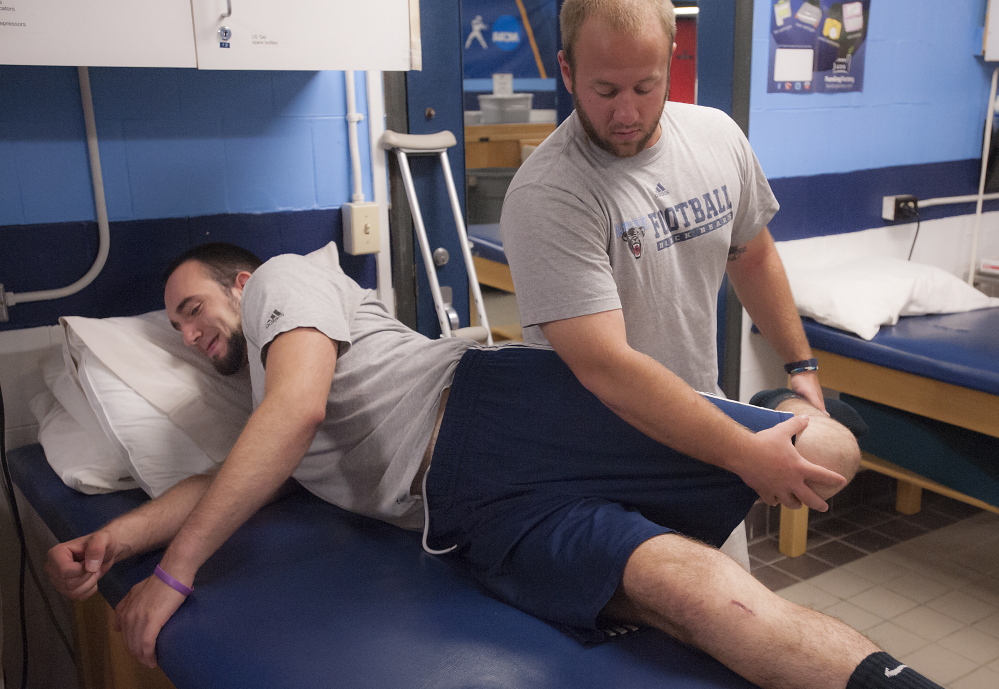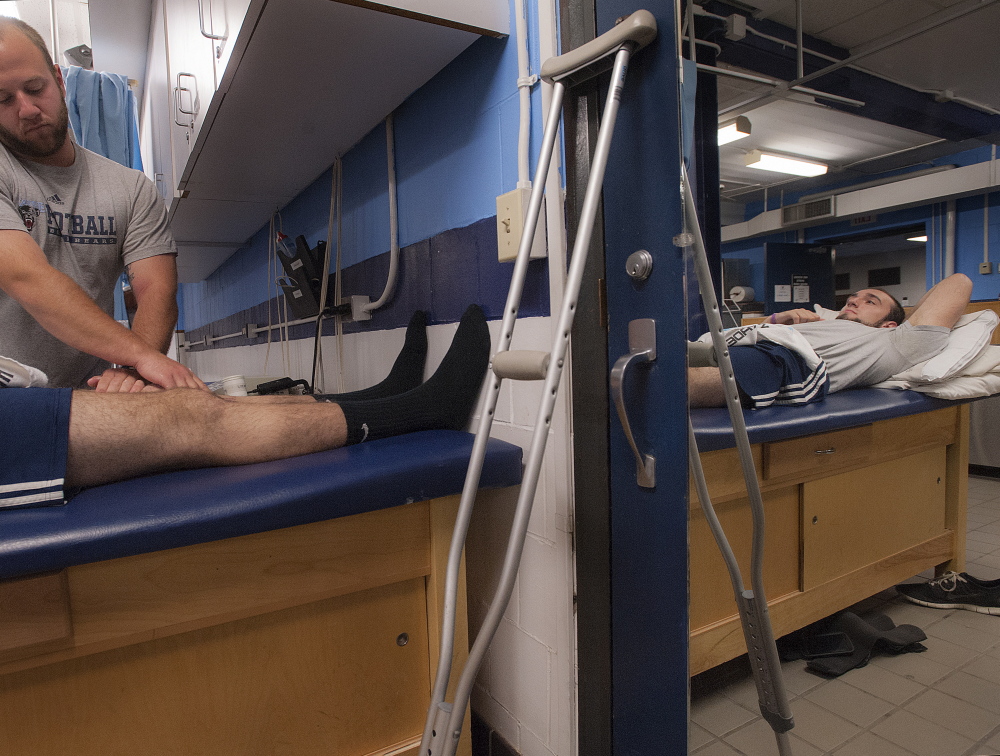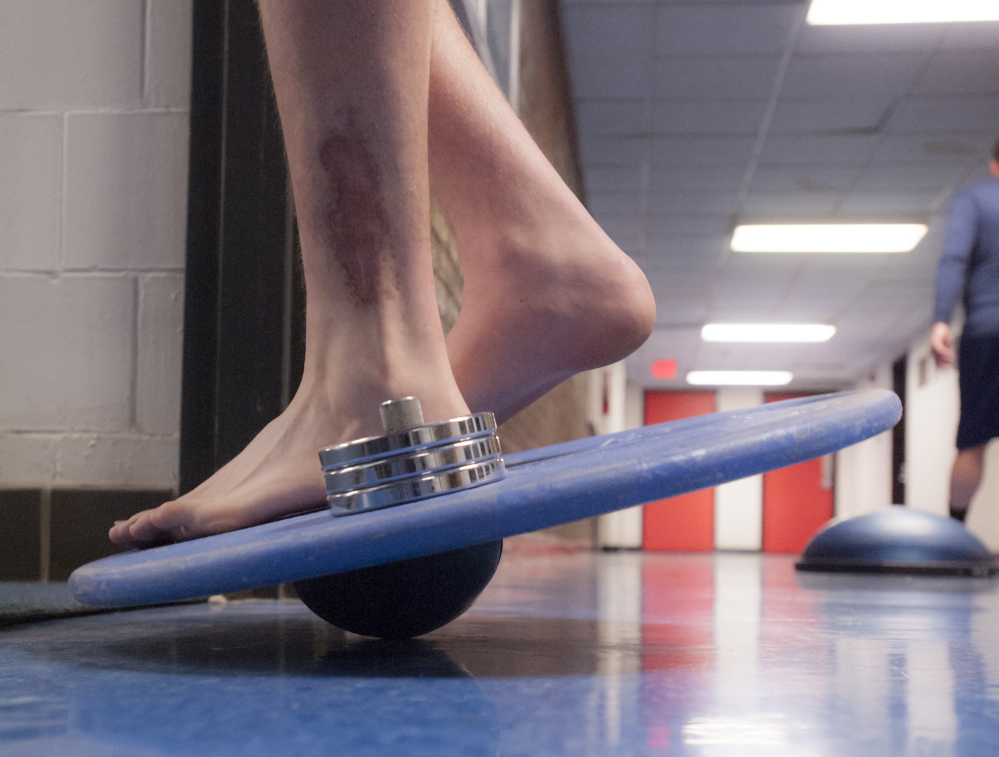Cal Schaefer is working to restore his mangled left leg in time to play football at the University of Maine this fall.
He is 10 months into a painstaking rehabilitation from the gruesome play that left him with two broken bones, one skin graft and a pile of medical bills.
And he is unwittingly at the forefront of a growing debate in college sports, whose athletes are calling for more rights and a bigger share of a nearly billion-dollar pie.
“You sign your letter of intent, you’re so excited to come play, you get to achieve a dream of playing college football. I don’t think anyone comes into college thinking about, ‘What happens if I get hurt?’ ” said Schaefer, an offensive lineman from Maryland.
“I don’t know anything about insurance. All I know is I’ve gotten more mail this year than I’ve gotten in my entire life from the two hospitals.”
The nature of the relationship between universities and their athletes is in flux, and no one knows how dramatic the changes will be. At Northwestern, football players were declared employees with the right to form a union in a March 27 ruling by the National Labor Relations Board in Chicago. The university has appealed that finding, which was limited to athletes at private universities.
The past two weeks, a California judge heard arguments from Ed O’Bannon and a group of former and current college football and basketball players seeking an end to the National Collegiate Athletic Association’s restriction on athletes being paid for the use of their names, images or likenesses. The much-anticipated ruling could change the very definition of amateurism.
But away from those attention-getting cases, a more elemental argument is looming – who should pay the medical costs when a college athlete gets injured?
It’s one of the reasons that the so-called “Power 5” conferences – the Southeastern, Atlantic Coast, Big Ten, Big 12 and Pac-12 – are looking to form their own autonomous subdivision within the NCAA. They want to be able to give their athletes more in scholarships and stipends, but also in medical coverage.
In California, a 2012 law established a “student-athlete bill of rights,” including a requirement that the state’s four Pac-12 universities – Cal-Berkeley, Stanford, UCLA and USC – pay for sports-related medical expenses. In Boston, a city councilor introduced a similar measure in May that would apply to Boston University, Boston College and Northeastern, schools with much smaller athletic budgets.
What happens if requirements like that extend all the way to Maine? It would save athletes like Schaefer, his family and their insurance company the $30,000 to $35,000 in medical bills that his injury and two subsequent surgeries have generated. And it would cost the state’s only Division I university three to four times the $442,217 it spent in 2013 on health care and insurance for its 450 student-athletes.
The debate centers on the complex question of what exactly a university owes its athletes, said Duke University School of Law professor Paul Haagen.
“Athletes are getting opportunities that they otherwise wouldn’t have. There’s a chance to showcase your talents. It’s a relatively high-profile activity,” he said.
“While all that’s true, it’s not an equitable division of the spoils. The institutions’ aggressive exploiting of the product is changing, and that’s raising a lot of questions about whether this really has anything to do with ‘the good old college try’ anymore.”
PROOF OF INSURANCE NEEDED
No one is claiming that universities are neglecting the health needs of their athletes. At UMaine, the only school in the state that offers athletic scholarships, there is a staff of six certified athletic trainers and a student assistant to tend to the Black Bears’ aches and pains year-round. The school spent $42,637 on athletic supplies in 2013, and another $296,580 on the salaries and benefits for the workers.
Athletes know that, from 7 a.m. to 6 p.m., they can come in to get preventive care, treatment for existing injuries or referrals to off-campus physicians. All at no cost.
But the NCAA requires that each athlete provide proof of insurance before being allowed to compete. This is usually a family policy, but athletes can buy the standard university policy available to all students if need be, at roughly $3,000 per year. And it’s that private insurance policy that will be charged if an athlete is seriously injured.
At UMaine, athletes are responsible for the first $10,000 in deductibles and co-payments.
Whether that’s fair – and what happens to athletes whose injuries linger well into their adulthood, after their playing days are over – is fueling the debate.
“There are things that athletes get as benefits, but a lot of the families don’t look at them as benefits. They think that’s what you’re supposed to do – he’s a Division I athlete,” UMaine head athletic trainer Ryan Taylor said of the level of care he’s able to provide.
“The parents throw their arms around us like, ‘You’re going to take care of our kid.’ You have these huge spectrums of what they want us to do and what they expect us to do.”
UMaine contracts with Eastern Maine Medical Center, at a cost of $15,000 a year, to provide doctors at its field hockey, soccer, basketball, football, ice hockey, baseball and softball home games. When something goes wrong, as it did for Stu Higgins in a Black Bear hockey exhibition game against New Brunswick last winter, there is a doctor on-site to make a diagnosis. For Higgins, it meant a trip to Bangor for an MRI the next day that revealed torn anterior cruciate and medial collateral ligaments and a partially torn meniscus in his knee. He had surgery in early March and expects to be ready to play when practices begin in September. The senior forward was already voted an assistant captain.
The medical bills are being taken care of by Higgins’ parents. UMaine does pay for a secondary insurance policy that covers its athletes after they’ve spent the $10,000. That policy will cost the school $124,000 this year. If medical expenses surpass $90,000 for a single incident, the NCAA provides a catastrophic injury policy for its athletes. That hasn’t been tapped into at UMaine in Taylor’s eight years there.
FREE REHABILITATION PROVIDED
Where universities like UMaine can really save athletes money, though, is by providing free rehabilitation after surgeries. Those costs could run $20,000 to $30,000 if the athlete had to go off-campus, Taylor said.
So that is what is keeping Higgins and Schaefer in Orono this summer. Higgins is working with the athletic trainer and the strength and conditioning staff to get his knee back in shape. He has been using an underwater treadmill to build strength and stamina without enduring the pressure on the knee that running outdoors would.
“I’ve had no issues. I feel like I’m in a good spot right now. I can’t say enough about the staff here. They’re the best,” Higgins said. “There are no qualms at all about the treatment I’ve received.”
Higgins’ praise for the university health care staff was echoed by five other athletes interviewed for this story. The athletes form a bond with their trainers and doctors. The only question for some is whether their families should be on the hook for the costs. None of the athletes knew precisely how much that was.
Schaefer broke his tibia and fibula in a football scrimmage Aug. 12, an injury reminiscent of the one notoriously suffered by former Washington Redskins quarterback Joe Theismann. Schaefer was playing right tackle when a running back was tackled into the back of his lower left leg.
“It was the right angle at the wrong time and snapped both bones clean in half,” Schaefer said. “It was one of the loudest noises I’ve ever heard. It just sounded like someone shot a cannon off in my ear.”
Schaefer had surgery the next day and missed what would have been his red-shirt freshman season. When swelling flared in October, he had to have a second surgery, a skin graft, which put him in the hospital for another week. The expected healing time is 12 to 18 months, meaning if all goes perfectly he’ll be ready to play when football practices begin Aug. 3.
He spends his time in the training room on the first floor of Memorial Gym, working on bending his repaired leg, stretching the calf, regaining his balance and strength. And forwarding insurance claim forms to his parents on the farm back in Maryland.
Schaefer said he’s never seriously questioned whether the physical toll is worth it.
“You can only play football for such a short amount of time in your life. I’m going to do everything I can to come back,” he said.
But what of the financial toll?
“It should be on the school. That’s the way I feel,” the economics major said. “I think anyone who’s ever had a surgery, who’s gotten hurt playing football, will tell you that.”
PERCEPTIONS OF FAIRNESS
UMaine Director of Athletics Karlton Creech, while sympathetic to the athletes’ feelings, said his budget is already stretched too tight. He pointed out that the national debate centers on powerhouse universities such as Alabama and Texas, where profits are ample. In Orono, only the men’s hockey team generates enough money to be self-sufficient and the athletic department relies on the university for its funding.
“There’s nowhere that I see to come up with that kind of revenue to pay for (full medical coverage for athletes) under our current system,” Creech said. “Are we at a competitive disadvantage if we don’t do it? Right now, we’re kind of in line with our peer group. No one in our conference (America East) can do this.”
But what is fair for his players?
“Fair is all about communication,” Creech said. “As long as the student-athletes know the situation that they’re coming into, that’s fair. And I think we are very fair with how we treat student-athletes and their families.”
Fair is in the eye of the beholder, of course. Athletes are quick to point out that scholarships are typically handed out year-by-year, with the universities retaining the right to pull the plug if things aren’t working out. Some see the money being generated and wonder if it’s being apportioned equitably.
Creech points out that few universities make money from sports. In 2012, USA Today reported that only 23 of 228 Division I public schools generated enough revenue to cover their athletic costs.
Those golden children are already separating from their NCAA brethren. It is evident in multimillion-dollar coaching salaries and chartered aircraft and other perks that schools like UMaine can’t match. The ability to offer full medical coverage to athletes, or to guarantee five-year scholarships, will just exacerbate that trend.
Haagen, the Duke law professor, foresees the five major conferences soon being allowed to operate under their own regulatory structure as a way to hold onto their dominance. The most lucrative sports will be able to split from the rest of the athletic department and not be forced to share all their money. Star athletes will get more than just the standard scholarship that bench players receive.
“Whether we’ll maintain the aura that there’s something called ‘intercollegiate sports’ that is the same at Bowdoin and Alabama, I don’t know,” he said.
‘THE PRICE OF DOING BUSINESS’
Whatever happens, it won’t absolve the UMaines of the world from having an obligation to care for their athletes, Taylor said. He knows money is tight in higher education, and can see how residents of the state would balk at paying higher taxes in order to cover medical insurance for the athletes in Orono.
Still, “You have men’s ice hockey, you have Division I football, you’ve got to take care of those kids. Because the injuries that some of them are sustaining, not only are they brutal, but some of them are going to have lifelong effects. Morally, it makes you feel a little dirty when you have a kid who just broke their leg and you’re taking care of them but Mom and Dad are flipping the bill,” Taylor said.
“I think Maine needs a Division I program. We’re it. And those people that are in those positions need to realize that it’s the price of doing business.”
On the training table next to where Taylor helps Schaefer mend his left leg, Kurt Massey quietly goes through his own rehabilitation ordeal.
Massey, a John Bapst graduate, is a walk-on defensive end who tore his ACL during the third week of spring practices. The red-shirt freshman has lost 20 pounds since his surgery, but that’s not all it has cost him.
An engineering major, Massey had an internship lined up this summer as a project manager. It was to pay $15 an hour and provide good experience for a potential career in construction management. But it also required field work that he now cannot handle.
“It’s been kind of bad,” he said of the loss of income on top of the medical bills that his family’s insurance carrier is responsible for. “The school has brought me in and they take care of me. They push everybody to their limits. They get the money by pushing me to the limits and I think they should pay for doing that.”
But Massey is not bitter about his situation, nor is he a quitter.
“My parents asked me if it was worth it, and for a second you’re like, ‘Do your parents know best?’ Then I thought about it. Football’s one of those sports where you put your whole heart into it or you put nothing into it,” Massey said.
“I put my whole heart into it, so there’s no point giving up now. I’m going to make it.”
Send questions/comments to the editors.





Success. Please wait for the page to reload. If the page does not reload within 5 seconds, please refresh the page.
Enter your email and password to access comments.
Hi, to comment on stories you must . This profile is in addition to your subscription and website login.
Already have a commenting profile? .
Invalid username/password.
Please check your email to confirm and complete your registration.
Only subscribers are eligible to post comments. Please subscribe or login first for digital access. Here’s why.
Use the form below to reset your password. When you've submitted your account email, we will send an email with a reset code.